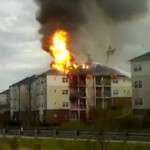Second Alarm Apartment Fire, VA
By Christopher J. Naum, SFPE on Nov 20, 2011 with Comments 0
 Arriving companies found heavy fire was coming from the building. Fire crews initiated an offensive attack but were forced to evacuate due to potential structural collapse considerations.
Arriving companies found heavy fire was coming from the building. Fire crews initiated an offensive attack but were forced to evacuate due to potential structural collapse considerations.
Operational Considerations at Garden Apartment Complex and Residencies
Fire ground operations at Garden Apartment Complex and Multiple Occupancy Residencies require due diligence and well-coordinated multiple company operations that have well established operating protocols, clearly defined ( but flexible) company and response duties and an effective and well-practiced and experienced cadre of company and command officers.
Due to the likely demands and complexities of evolving and expanding incident conditions at fire involving Garden Apartment type buildings and complexes, couple with the civilian life safety concerns due to occupancy density and numbers, immediate and timely resources are necessary to conduct multiple and concurrent functional assignments that demand effectiveness, efficiency and trained company compositions.
Strategy and Tactics at Garden Apartment Complex and Residencies required special instructions, insights and knowledge that goes well beyond the practices and methodologies typically deployed at single family residential fire incidents.
Multiple occupancy dwelling units, occupancy loads, multiple floors, building construction, structural systems and assemblies, construction and material, methods of construction and building and occupancy layouts and configurations results in fast spreading and extreme fire conditions, common avenues for internal and exterior fire travel, congested travel paths and access/egress points, multiple hose line deployment strategies with adequate fire flows, effective building laddering, forcible entry support and concurrent, mobile and skilled search and rescue capabilities.
The ability to deploy and operate multiple hand lines is mission critical at fires in these multiple occupancy dwellings. As are a number of other strategic and tactical functions; but again, If the fire is controlled and goes out- all the other escalating, concurrent and immediate demands, needs and requests along with highest risk factors for survivability to occupants and firefighter alike diminishes rapidly and can be managed.
Here are some discussion points to chat about around the kitchen table;
- Are your engine companies effectively set up and outfitted to stretch out and deploy extended lines, multiple lines on common floors or within various floor elevations?
- Have you and your company practiced coordinated multiple company search and rescue protocols for multiple occupancy floor areas?
- Have you considered the needs, impacts and operational deployment for a RIT on a common floor during extreme fire conditions that required interior common hallway access and extraction of a firefighter in distress or incapacitated?
- Do you have the capability to deploy and implement multiple companies for coordinated roof ventilation operations? IF so, have they training together in the past?
- How effective and knowledgably are you and your company in initiating and completing multiple trench, strip or louver roof ventilation cuts?
- Are you aware of the signs for potential or imminent collapse for the various types of garden apartment buildings in your response area? Did you know there are different considerations based on the vintage, age and construction systems and assemblies utilized?
- When was the last time you either pre-fire planned any of your garden apartment building or complexes? Or did a company walk-through?
- Which ones are protected by a fixed sprinkler system?
- Do you what the water fire flow capabilities are for the hydrants and system in any of these garden apartment building or complexes?
- Have you done any table top exercises considering a standard alarm assignment fire, or an escalating multiple alarms incident?
- Do you consider occupancy risk versus occupany type for the buildings you respond to?
- Are your considering the effects of extreme fire behavior and the potential for wind driven fire conditions in your IAPs?
- Are you considering the collapse and compromise potential for floor and roof assemblies in your assignments?
- Are you fully prepared for immediate or multiple RIT needs and deployments?
- Do you understand how these garden apartment buildings are constructed, configured and will impact your strategic and tactical assignments?
- Do you have the right skill set for performing safely and effectively in your assigned role and responsibilities? If not, what are you going to do about that gap?
Filed Under: Adaptive Fireground Management • BuildingsonFire • Combat Fire Engagement • Predicative Strategy





























